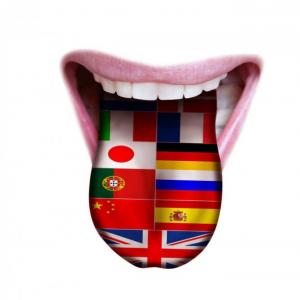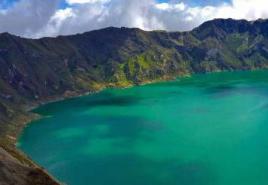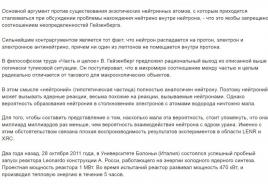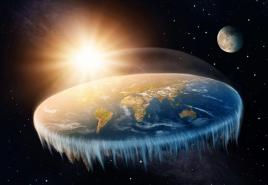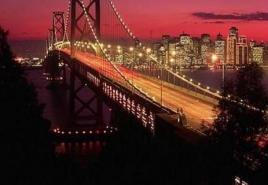Environmental problems in italy in brief. Italy has the dirtiest air in Europe
Several national parks have been established in Italy to protect flora and fauna; the largest of which are Gran Paradiso, Stelvio, Circeo, Abruzzo. These are only small islands of wildlife with a total area of \u200b\u200babout 2 thousand km². Gran Paradiso and Stelvio are set up in the Alps to protect alpine flora and fauna. Abruzzo is set aside for the same purposes in the highest part of the Apennines. Circeo was established on the coast to protect not only forests, but also peculiar coastal forms - grottoes, cliffs, etc. Protective areas are created to protect soil from erosion. However, all these measures are far from sufficient to preserve the Italian nature from the rapid and steady change by its human activity.
Lack of proper organization of nature protection leads to further destruction of forests, irrational use of land for construction, reduction of the area of \u200b\u200bnational parks, destruction of forest fauna. As a result of desertification of mountain villages on abandoned lands located mostly on steep slopes, soil erosion, the danger of landslides and floods, increases.
The pollution of inland and sea waters is very noticeable. Many rivers have already become dangerous to use for water supply to cities. Industrial waste from numerous coastal industries pollutes the Mediterranean Sea, damaging coastal fauna and flora. For example, the discharge of sewage into a lagoon near the city of Cagliari on the island of Sardinia endangers flamingos and other rare birds that stop here during seasonal migrations. The unbridled growth of seaside tourist centers has led to the fact that about half of the Italian coast can now be considered destroyed or, at least, lost for the rational development of tourism.
The habitat in large industrial cities is in an endangered state. Italian cities are among the last in the world for landscaping. The development of industry and road transport has led to air pollution, which in the centers of the chemical industry often exceeds permissible standards.
However, in recent years, the situation has begun to gradually change for the better. Italy is the only G8 country that has abandoned the construction of nuclear power plants. The government, concerned about the environmental situation in the country, took decisive measures to improve it. First of all, funding for environmental programs was significantly increased both at the national and regional levels. An important step towards reducing harmful emissions into the atmosphere was the signing and subsequent ratification by Italy of the well-known Kyoto Protocol. In 2005, a law restricting smoking in public places came into force. All this allows Italians to look to the future with optimism.
You've probably already heard about at least one environmental problem in Italy - for example, Venice is sinking under the water. But there are others, no less frightening. Let's talk about them today. Perhaps this is how you want to come here faster so as not to miss anything interesting until it went under water, melted, burned out, or just flew into a pipe 🙁
FLOODING OF CITIES
Because of the melting glaciers, the water level in the seas is gradually rising, which leads to a gradual flooding of territories inhabited by humans. During the 20th century, the ocean level has already risen by 15 cm. According to researchers, in a hundred years such world capitals as Bangkok, New York, Tokyo, Venice and Amsterdam may go under water.
Why? Each rise in temperature by five degrees threatens to raise the water level by one meter. And scientists predict that if we do not stop the greenhouse effect that causes global warming on earth, the thermometer will show five degrees more than today, already in 2100.
This picture can be seen in Venice more and more.
Many of the coasts loved by tourists will disappear forever, for example, the Adriatic coast of Italy with thousands of wide beaches with white fine sand (we just live and relax on these beaches, what a pity if my grandchildren never see them :(). And also the territory of the most beautiful islands such as Sardinia and Sicily, it is estimated that only one centimeter rise in the water level will cause Italy to lose 24,000 square kilometers of soil that is located along the coastline - they will simply go under water.
DROUGHT AND DESERTIFICATION
On the other hand, global warming is causing another problem - the drought is getting worse. Yesterday, the former fertile lands become unusable and are gradually turning into deserts. In Italy, 27% of the territory has already been attributed to risk zones (all the same islands of Sicily and Sardinia, as well as the regions of Apulia, Veneto and Liguria). Every year the lands falling into disrepair result in the loss of 28 billion tons of agricultural crops for Italy.
FOREST FIRES
There are an average of 50,000 forest fires in Italy each year, of which approximately 36,000 are classified as intentional arson. In 2008, 110 thousand hectares of land were in smoke, the southern regions of Sicily and Campania were most affected.
MELTING SNOW 
After ten years, snow that lies at an altitude of less than 1500 meters will melt and disappear. Even in the Alps. If among the readers of this article there are skiers visiting Italy from year to year, you yourself could notice how the seasons are getting shorter, the sun is getting more, the snow is less, snow cannons are saving so far, but this is not quite right ... Such a situation caused by a global rise in temperature on our planet. So over time, skiers will have to climb ever greater heights - where there is still snow.
THE PROBLEM OF VENICE
It is said that Venice (which was flooded 50 times from 1993 to 2002, and the water level rose by 23 cm in the twentieth century) can be protected in two ways.
The first is to build a dam around the island to separate it from the sea and regulate the water level. Second: to raise the island and the city standing on it. Although this option seems fantastic, money has been allocated for this project and it is being implemented.
The first dam idea, a project called "Moses", involves the installation of 78 mobile barriers on a two-kilometer stretch at the entrance to the Venetian lagoon. The cost of "Moses" is about four billion euros.
Below is a diagram of the construction of dams that will regulate the water level in the Venice lagoon.

All buildings in Venice are built on wooden piles driven into the ground to a depth of three to ten meters. The piles are located in a thick palisade, on top of them are platforms made of interconnected oak and larch logs, and already on them are stone foundations. For example, more than a million oak, alder, larch piles were driven into the foundation of the Church of Santa Maria della Salute (this work took over two years), the stone Rialto bridge stands on twelve thousand piles.
The buildings themselves in Venice are 90% brick, although they look like stone because they are plastered. Brick is a porous material that can absorb water and move it along the capillaries. The builders of Venice knew this well, so they installed a brick foundation on the base of oak piles, and at the level of the sidewalk they laid one or two rows of stones brought from the Istrian peninsula, located opposite Venice on the other side of the Adriatic. The dense composition of this stone prevented the capillary rise of moisture. However, during floods, this barrier is flooded, salt water enters the brickwork and rises through the capillaries to a height of four meters.
Salt water is aggressive in itself, but in the lagoon it is still polluted by industrial effluents from the industrial area of \u200b\u200bMarghera, contains iron, phenols, cyanides, chlorine, and detergents. Salted and impregnated with chemicals, brickwork turns into a soft substance and collapses. Air pollution from industry just a few kilometers from Venice, combined with humid sea air, is causing destruction and artwork. Corrosion hit the metal, and the city hall had to remove the four bronze horses from the facade of the Basilica of San Marco and replace them with a copy. The marble columns were undermined by a kind of "stone cancer" - the marble lost its strength millimeter by millimeter and turned to dust at the slightest touch.

Another attack that overcomes Venice is the ubiquitous pigeons.
On the Piazza San Marco, their clouds appear and disappear - this is due to the fact that the city hall successfully wins in the fight against birds, then loses this fight to animal defenders.
Of course, tourists who don't even care about the problems of Venice love to be photographed with pigeons on their shoulders, heads and other parts of the body.
Nearby, you can buy food bags for birds.

And now, finally tired of bird battles, ecologists put forward the last argument: the water in the lagoon rises not only from the melting of glaciers, but also from bird droppings, which are sent by tons of pigeons flying over Venice into the water ...
FOR REFERENCE: WHAT IS THE "GREENHOUSE EFFECT" and "OZONE HOLE"?
The secret of the "greenhouse effect". When you enter a greenhouse, a higher temperature is immediately felt. The glass allows the sun's rays to pass through, which heats the air inside the greenhouse and prevents the heat from returning.
Carbon dioxide, which accumulates in the high layers of the atmosphere, acts on the same principle of glass. It lets the sun's rays through, which heats the earth, and prevents heat from escaping from the earth back into the atmosphere. If not for this gas, then the temperature on the earth would be 30 degrees below zero.
But recently, too much carbon dioxide has accumulated in the atmosphere, and it has become too warm. Every year, people emit seven billion tons of harmful gases into the atmosphere; our forests cannot absorb this amount even if their area is doubled.
That is, it is useless to grow forests, it is necessary to reduce the amount of emissions. And these are: car exhaust, heating, combustion of combustible fuels - coal, oil and methane. We need to look for new sources of energy, such as the sun, wind, water. Prefer methane from fuel, as it is the least toxic.
 The ozone hole.
Ozone molecules form in the atmosphere, at an altitude of 25-30 kilometers, a very thin but very important layer of gas that protects the earth from the sun's ultraviolet rays. These rays are dangerous for the inhabitants of the earth, as they cause skin cancer. Doctors confirm that as the ozone layer decreases, the number of tumors on the skin increases.
The ozone hole.
Ozone molecules form in the atmosphere, at an altitude of 25-30 kilometers, a very thin but very important layer of gas that protects the earth from the sun's ultraviolet rays. These rays are dangerous for the inhabitants of the earth, as they cause skin cancer. Doctors confirm that as the ozone layer decreases, the number of tumors on the skin increases.
The ozone hole, that is, the loss of ozone in the atmosphere over the Atlantic, was discovered in 1985. Substances used in aerosol cans, refrigerators and air conditioners provoke ozone losses.
1. Italy.
1. Introduction
2. The name of the country (modern and historical).
3. Its geographic location.
4. The history of the country.
5. Composition of the country's population (ethnic, racial, age).
6. The largest cities, their specialization.
7. Availability of natural resources, their use in the country's economy.
8. The level of development of the country's economy, the problems associated with this.
9. The importance of the country in the world division of labor.
10. Environmental problems, ways to solve them.
11.Ways of development of the country in the world economy.
12. Conclusion.
13. List of references.
3.Introduction.
The economic geography of foreign countries studies the patterns of development and distribution of the population and economy both on the globe as a whole and in individual foreign countries. One of these states, which I have chosen for my research, is Italy.
This work pays special attention to the economic development of the state, as well as reflects various facts, hypotheses and theories concerning this state; various options for solving problems are compared and their point of view on the peculiarities of the development of Italy is expressed.
In my work, I touched upon interesting facts from the development of this country.
- 4.Country name (modern and historical)
- The official name of the country is the Italian Republic.
- The origin of the word "Italy" is not exactly known. According to one of the more common versions, the term “Italia” was formed from the Greek “Oscan Viteliu”, which means “land of young cattle” or “land of calves”. The bull was a symbol of the southern Italian tribes and was often depicted gutting the Roman Wolf.
- There is also another version. The Greek historian Dionysius of Halicarnassus connected the name "Italy" with the name of Ital, the king of the nomads - enotra.
5. Geographic location.
Italy is located in the extreme south of Europe. The country's territory (301 thousand sq. Km) includes the Apennine Peninsula, large islands (Sicily and Sardinia) and numerous small islands (Aegadian, Lipari, Tuscan archipelago, etc.) In the north, in the mainland, it borders on France, Switzerland, Austria, Slovenia. In the south, across the Strait of Tunis, it neighbors Africa. Of the 9.3 thousand km of Italian borders, 4/5 falls on the sea. All the seas washing the shores of the country are the waters of the Mediterranean Sea.
6. The history of the country.
- The history of Italy goes back centuries and at the same time this state, which is just over 127 years old. The earliest basis of Italy was the Italic tribes, which made up the majority of the population of the Apennine Peninsula in 1 thousand BC. e. One of them is the Latins who founded Rome in the 5th - 7th centuries. BC e. conquered the peninsula. In the future, Rome became a major earthly power. The population spoke Latin. During the 5th - 7th centuries. individual regions of Italy were conquered by the Byzantines, Franks, Arabs, Normans, and the population was mixed. In 1871, the creation of the Italian Kingdom was officially proclaimed. The unification of Italy was completed in 1871. After the annexation of Rome and the abolition of the secular power of the popes. In 1946 Italy became a republic on the basis of a referendum.
7.Composition of the country's population (ethnic, racial, age).
The population of Italy is about 57910,000 people, the average population density is about 192 people per sq. km.
Ethnic groups: Italians - 98%, Germans, Slovenes, Albanians, Greeks, French. Language: Italian (state), in some regions they speak German (Bolzano region), French (Valle d'Aosta region), Slovenian, Greek, Albanian. Religion - Catholic (98%), Protestants, Muslims, Jews.
Italy is one of the most densely populated countries in Europe. Population distribution is influenced by the intensive urbanization process. The bulk of the urban population is concentrated in Northern Italy. Average life expectancy: 74 years for men, 81 years for women. Birth rate (per 1000 people) - 11. Death rate (per 1000 people) - 10.
8. The largest cities, their specialization.
Rome, the capital of Italy, a great transport hub: the international airports of Leonardo da Vinci, di Fiumicino and Ciampino, the metro operates. An important financial and industrial center of the country with developed mechanical engineering, chemical, pharmaceutical, printing, furniture, light and food industries, arts and crafts, film industry. One of the largest tourism centers in the world.
More than 20 institutes and academies work here, engaged in the study of problems of fine arts, theater, music, cinema; Astronomical Observatory, National Council for Scientific Research, National Nuclear Center (The Club of Rome is a world-famous research center that brings together the world's largest scientists
9. Milan, a city in northern Italy, on the Padan plain, an important economic and cultural center of the country, a leader in the chemical (plastic production) and textile industries, mechanical engineering (cars, machine tools, electrical engineering), metallurgy, oil refining, light, food, printing, glass, pharmaceutical industries ... A major banking center in Italy, the center of the fashion industry, one of the most significant centers for the sale of silk. The boards of Italian companies Ferrari, Fiat, Epson and others, as well as the largest Italian stock exchange, are located in Milan.
Genoa, a northern Italian city, on the shores of the Genoa Gulf of the Ligurian Sea. One of the largest ports in the Mediterranean (import of oil, coal, scrap metal, cotton, timber, grain; export of finished industrial products).
- 10. Availability of natural resources, their use in the country's economy.
Despite the fact that Italy has a variety of minerals, their deposits are mostly small, scattered over the territory, often inconvenient for development. One of the most famous minerals in Italy is iron ore. Italy is much richer in deposits of polymetallic ores, in which lead and zinc. Italy occupies one of the first places in the world in terms of reserves of mercury ore - cinnabar. Deposits of bauxite and manganese are also being developed. There are deposits of brown coal and low-quality coal, oil reserves. Natural gas deposits are very important for the country's economy. Deposits of sulfur, potash and rock salt are concentrated on the island of Sicily. It should be noted that the bowels of Italy are rich in building materials - marble, granite, travertine, etc. The famous white Carrara marble is mined in Carrara (Tuscany).
Italy's energy resources meet its energy needs by only 15%. The rich natural potential of the country, combined with the unique hydro resources of the Alps, are undoubtedly of great value and are of great importance in the economy of modern Italy.
Perhaps the most sought after natural resources in Italy are the sun, sea, mountains and magnificent natural landscapes, along with healing thermal springs. All this is well sold to both tourists and indigenous people of the country and makes up the bulk of the gross product of this tourist country.
11. The level of development of the country's economy, the problems associated with this.
The Italian economy produces high quality consumer goods, mainly by small and medium-sized enterprises. Italy also has a significant shadow economy, which according to some estimates accounts for up to 15% of the country's GDP. The country's official debt balances are 100% higher than GDP.
GDP per capita is $ 31,000. The country's GDP is formed as follows: 2% comes from agriculture: 26.7% - industry, 71.3% - services. Italy ranks 6th in the world in terms of economic development. In the late 1990s, the processes of European integration, the introduction of the euro into circulation caused a revival of the economy, stimulated the further development of small and medium-sized businesses.
Labor force employment in the economic sectors is distributed as follows: agriculture - 4.2%, industry - 30.7%, services - 65.1%.
Italy is divided into the industrial North and the agricultural South with high unemployment rates. In the northwest of the country, in the Milan-Turin-Genoa "Industrial Triangle" zone, 80% of the country's industrial production is concentrated. The Novus Ortus Innovation Center, which aims to boost the economic development of southern Italy, is the country's largest technopark. Located in the south of the country near the city of Bari.
On about. Sicily, the Padan plain and the continental shelf of the Adriatic Sea produce oil and natural gas, in Sardinia and Tuscany - brown and bituminous coal, polymetallic ores, pyrite, in Sicily - sulfur and potash salts, in Tuscany - marble and granite. Despite having its own energy resources, Italy is 80% dependent on their imports.
12. The importance of the country in the world division of labor.
Considering the importance of Italy in the international division of labor, it is worth noting that the development of Italy in the field of innovation is characterized by a slow pace. Italy lacks the conditions for a highly effective scientific environment.
The Italian industry is organized in such a way that industrial giants work closely with small and medium-sized businesses.
Thus, Italy does not have a significant place in the international exchange of technologies and runs the risk of becoming an importing country of ready-made technologies, which is typical for third world countries.
Occupying an uncertain position between developing and developed economies, Italy runs the risk of remaining in a narrow niche of industrial production. Of course, such sectors of the Italian economy as tourism, the production of footwear, which is known throughout the world for its quality, the fashion industry, woodworking products, in particular furniture - all these industries will not face serious competition in the foreseeable future. However, a significant proportion of industries could be seriously damaged by heightened international competition. The decline in the competitiveness of goods due to the lack of technological progress will have an extremely negative impact on Italy's GDP and the level of welfare of the country as a whole.
13. Environmental problems, ways to solve them.
Ecological problems are that due to the small territory and high population density, in modern Italy, the issue of waste processing is acute. Reasons: the unfavorable social environment in the south of the country and, in particular, the climatic and demographic characteristics of the region (the hot dry climate of Italy contributes to the rapid spread of unsanitary conditions in densely populated cities).
The lack of proper organization of nature protection leads to the destruction of forests, irrational use of land for construction, reduction of the area of \u200b\u200bnational parks, destruction of forest fauna. As a result of desertification of mountain villages on abandoned lands located mostly on steep slopes, soil erosion, the danger of landslides and floods, increases. The pollution of inland and sea waters is very noticeable. Many rivers have already become dangerous to use for water supply to cities. Industrial waste from numerous coastal industries pollutes the Mediterranean Sea, damaging coastal fauna and flora. The unbridled growth of seaside tourist centers has led to the fact that about half of the Italian coast can now be considered destroyed and lost for the rational development of tourism.
14. The habitat in large industrial cities is in an endangered state. Italian cities are among the last in the world for landscaping. The development of industry and road transport has led to air pollution, which in the centers of the chemical industry exceeds all permissible standards. In general, the problems of environmental protection are becoming more acute in Italy every year, and not enough funds are allocated to solve them.
Ways to solve environmental problems.
1. Creation of various kinds of treatment facilities, waste disposal and processing, reclamation of disturbed lands, etc.
2. Thought-out, rational placement of various industries (chemical, petrochemical, ferrous and non-ferrous metallurgy).
3. Correct organization of nature protection.
4. Development and implementation of a fundamentally new safety technology of enterprises, the transition to low-waste and waste-free production.
15.Ways of development of the country in the world economy.
The development of the Italian economy is closely related to external factors. Lack of natural resources was a decisive factor in choosing the path of economic transformation: to export in order to survive. This determined the place of Italy in the international division of labor.
Thus, export promotion is an important area of \u200b\u200bItalian economic policy.
In political and economic relations, Italy is connected with many countries of the world, is a member of most of the economic and political organizations that emerged after the Second World War. She is a member of the Organization for Economic Cooperation and Development (OECD) since 1960, the European Coal and Steel Community - since 1952, Euratom - since 1957, the Western European Union - since 1954. The main foreign trade partners of Italy are Germany, France , USA, UK. In 1920, trade relations were established between Italy and the USSR (now the Russian Federation). They are supported between our countries now.
16. Conclusion.
Having got acquainted with the completed work, you were convinced that Italy is a highly developed country with its own characteristics.
It has a very favorable and advantageous geographical position, which is of great importance in the development of transport. Italy leads the way in many industries and agriculture. Progressing in many sectors of the economy, culture and science. It is a country with individual natural resources. Italy is trying to go forward in everything and is not inferior to many countries of foreign Europe. It is of great importance in the development of recreation and tourism.
Italy is a very promising small state.
17.List of literature
- 1. "Countries of the World" - A guide for scholars and travelers.
2. Encyclopedic reference book "All countries of the world".
3. Encyclopedic reference book "The whole world".
4. Small encyclopedia of countries.
5. Economic geography of foreign countries.
Almost 90% of European cities have exceeded the permissible air pollution standards, but none can compare with Italy: the worst situation was in, and of the 30 most polluted cities in Europe, 23 are Italian.
Despite the fact that the amount of polluting emissions in Europe as a whole has decreased, 88% of the inhabitants of European cities are still exposed to substances recognized by the World Health Organization (WHO) as harmful to the body. This is the conclusion reached by the European Environment Agency in its latest study on air quality in Europe. Padua was the first in the list of the most polluted cities, 22 more Italian cities "lagged behind" not much.
Reflecting the general picture in Europe: the number of particularly harmful super-fine suspended particles in the air exceeds the permissible level in 91-96% of cases (according to the Pm 2.5 standard), the concentration of ground-level ozone (again, the most dangerous) exceeds the WHO indicators in 97-98% of cases.
In 2011, the city exceeded the maximum permissible air pollution limits for 104 days. “The situation did not improve much in 2012,” says Lucio Passi, Legambiente's representative in Padua. "Last year there were 90 days of ozone exceeding the norm."
Dear reader, to find an answer to any question about your vacation in Italy, use. I answer all questions in the comments under the relevant articles at least once a day. Your guide in Italy Artur Yakutsevich.

The cause of the problem lies in the massive use of vehicles. “The regional authorities can no longer hesitate to implement serious measures that would reduce the number of cars on the roads, and with them the level of smog,” continues Passy.
The Padan Plain disaster
In terms of ozone content, Padua is followed by Lecco, where in 2011 for 100 days experts recorded an excess of WHO standards. Next comes the Spanish Caceres, and then Italy again: Pavia, Reggio, Emilia, Treviso and, Verona and Varese, Modena, Udine and Novara. Italy holds an absolute record with rates three times higher than normal, with the country's most polluted area being the Padan Plain, including its agricultural land.

Transport remains the main problem, followed by industry, agriculture and heating of buildings. “The current situation affects the quality of life of citizens, as air pollution causes diseases of the respiratory system and shortens the life expectancy of the population,” said the director of the agency, Hans Bruynings. He then asked Europeans to reduce their negative environmental impact, which depends on the means of transport they choose to travel.
↘️🇮🇹 USEFUL ARTICLES AND SITES 🇮🇹↙️ SHARE WITH YOUR FRIENDS


